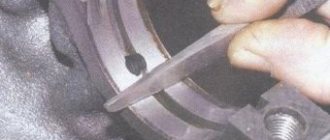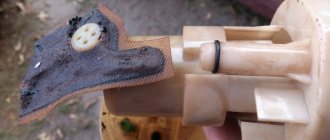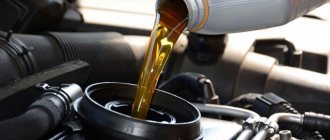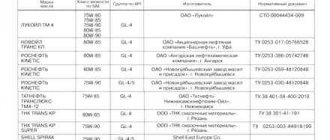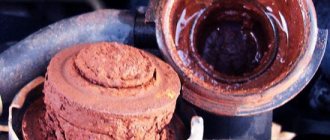A manual transmission (MT) consists of shafts, bearings, gears and synchronizers, and all these parts cannot work without oil. The lubricating film it provides protects rubbing elements, facilitates gear shifting, removes excess heat and cleans parts from deposits.
Despite the fact that oil has cleaning properties, it, along with transmission wear products, is also a source of contamination of the manual transmission. That is why when replacing old lubricant in a gearbox, it is recommended to flush the manual transmission.
Let's look at how to do this in more detail.
Causes of manual transmission contamination
The most common reason for contamination and the need to flush the gearbox is water getting into the mechanism. The manual transmission is leaking. It must be in contact with the atmosphere to avoid the formation of excess pressure or vacuum due to temperature changes.
The valve, which provides air inflow or outflow (breather), is located at the top of the box. Under normal operating conditions, it works normally, but if the car gets into a deep puddle, water enters the breather. The box cools sharply, and the transmission oil turns into an emulsion. If such a liquid is not replaced in time, the process of hydrolysis begins, that is, “saponification” of the oil. At the same time, it loses all its lubricating and cleaning properties.
Transmission fluid can also cause contamination of the manual transmission if it overheats for a long time. This occurs when driving for a long time at high speed or in off-road conditions, or when towing a heavy load. Due to unacceptably high temperatures, the oil in the box begins to “cook”, forming something like an ointment.
Deposits in the manual transmission oil pan, as well as on other parts of the unit, are caused by oxidized oil if oil change intervals are not observed.
Manual transmission flushing: what is it for and when is it necessary?
A car is a complex unit consisting of many components, elements and parts. One of these components is a manual transmission, the correct operation of which requires not only compliance with operating rules, but also timely and high-quality maintenance.
Maintenance of a manual transmission consists of checking the oil level in the box, partial or complete oil change, flushing the manual transmission (if necessary), timely repairs, adjustments, etc. Next, we will look at when and why you need to flush the manual transmission before changing the oil.
Read in this article
What and how to flush the gearbox when changing the oil?
To clean the gearbox before the next oil change, it is better to use specialized flushing agents.
They allow:
- Soften and remove various deposits and wear products of gearbox parts
- Clean oil channels and improve oil circulation
- Completely remove old oil
- Extend the service life of oil seals and rubber seals
Before carrying out the procedure of flushing the box and changing the oil, the manual transmission must be warmed up. The car should be placed on a flat surface (preferably on an overpass).
After draining the old oil, flushing fluid is supplied to the box through the filler hole (its quantity must correspond to the volume of the gearbox).
Then the engine starts and idles for 10-15 minutes. There is no need to drive anywhere or change gears.
The flushing agent is drained and fresh oil is added.
Operating principle of flushing oils
Table for assessing the degree of contamination of engine parts.
Before changing the gearbox oil, let the engine run for a while. The heated grease will drain faster and better. After draining the old fluid, fill in the flushing fluid in exactly the same volume as the working fluid. Let the engine idle again. In about 20 minutes, the washing liquid should have time to rinse the entire box. The used flushing oil must be drained and replaced with working oil.
Do I need to use a flush? Flushes are practically not used abroad, so you won’t see flushes from Castrol or Shell on store shelves. Such manufacturers claim that if all maintenance standards are observed, there is no work to be done for flushing. But this statement is true subject to a number of conditions:
- The car must be new, from the showroom.
- The quality of the fuel must be impeccable.
- The oil is changed frequently and the transmission is serviced regularly.
These conditions are not always feasible for our country. Cars are not always purchased from a dealership, and recommended regulations are almost never followed. It is for such cases that flushing comes in handy.
Innovation in the market. Quite recently, a new product appeared on domestic shelves - LAVR. This tool opens up completely new perspectives in car maintenance. Usually no one really thinks about why the checkpoint is not usually cleaned of contamination?
Benefits of LAUREL oil.
Gearboxes and axles are also often left without proper attention. If you think about it, these components bear no less load than an engine in which the oil is changed regularly.
The reason lies in the fact that car manufacturers consider these components to be maintenance-free. LAVR became the first domestic product for cleaning gearboxes, drive axles and transfer mechanisms of both cars and trucks. This product is indicated for use at every oil change in these units. The manufacturer guarantees the following results:
- Absence of wear products during operation in gearboxes and other components.
- Increased service life of units where flushing is used.
- Restoring the plasticity of rubber seals.
- The use of reducing and antifriction additives significantly enhances the effect of using LAVR.
What is manual transmission flushing oil?
Traditional flushing agent (for both engine and gearbox) is an inexpensive mineral oil with the addition of detergents and various additives that prevent wear of gearbox elements. As a rule, zinc and phosphorus are used as additives, and calcium is used as detergents.
The flushing liquid not only washes away the remaining used oil, but also neutralizes the acidic environment that has formed since the last oil change.
If the contamination is serious enough, the box is disassembled to remove it, after which the individual elements are cleaned mechanically.
What you need to prepare for washing the automatic transmission
Automatic transmission washing, even at home, should be carried out at a professional level. This means that you need to prepare all the tools and materials so that you don’t have to run around looking for them later.
To flush the automatic transmission you will need the following materials and tools:
- container for draining waste liquid;
- lint-free cloth;
- wrenches, sockets and ratchets. It is advisable to have these tools included;
- an overpass or a small hill to crawl under the car;
- flushing oil to clean the automatic transmission from dirt;
- oil that will be poured into an already clean unit.
All these tools must be prepared and left in the garage or the place where self-disassembly and washing will take place. After this, you need to get behind the wheel to begin the procedure.
Attention! Vehicle service centers use special washing units with high-pressure units. Therefore, the car owner decides to wash the machine himself or use the services of a service station.
The meaning of washing the machine
It was previously noted that over the course of operation of an automatic transmission, the oil in its channels and the channels themselves gradually become contaminated by production. Dirt, represented by metal and rubber shavings, with its accumulation begins to disrupt the operation of the machine, which significantly affects the comfort of its use. In order to prevent problems with the gearbox or to get rid of existing faults, many car enthusiasts resort to flushing this unit.
The essence of washing the automatic transmission is to clean the accumulated dirt from the cavities of the box using any available method. As a rule, such a procedure is carried out by passing a certain amount of oil through the box channel system and then draining it. Much less often, special flushing agents are added to the transmission fluid or the box is completely disassembled to clean all parts manually using compressed air and gasoline.
Note that each flushing method has its place and will be useful for the functioning of the automatic transmission. Properly carried out cleaning will, at a minimum, be able to:
Despite the controversial opinion about automatic transmission flushing in the automotive sector, it is worth noting that it still has some use. However, to get a real effect, we repeat, a competent approach to cleaning the box is extremely important.
How to flush the automatic transmission yourself
If the car owner does not know how to flush the automatic transmission on his own, then the following instructions will help him with this.
Read
Replacing the automatic transmission torque converter oil seal with your own hands
The usual procedure is carried out by draining the used oil and adding new oil, starting the engine and repeating the process using the displacement method. This method is used when completely replacing the lubricant. In this case, the box is not dismantled.
You can wash the box this way by following the steps below:
- Start the engine and warm up the vehicle's automatic transmission to operating temperature.
- Drive onto the overpass.
- Stop the engine and drain the used oil into a special container.
- Disassemble the pan and clean it of metal shavings and carbon deposits.
- Remove the old filter and install a new filter device.
- Reassemble everything in the reverse order, not forgetting to change the seals on the pan and the drain plug.
- Fill in new flushing oil as much as was drained.
- Now you should disconnect the return hose from the cooling radiator and insert the free end into a five-liter bottle.
- Ask your partner to start the engine.
- A black liquid will flow into the bottle. Wait until it changes color to light.
- Drain all oil.
- Turn off the motor. Reinstall the hose.
- Add as much original lubricant as has spilled out.
This will complete the cleaning step. The old oil was replaced by new oil. Car owners believe that this is enough to flush the automatic transmission. Some people use cleaning additives in this case, although experts do not recommend it. Since their effectiveness has not been proven, various impurities can harm the automatic transmission.
Attention! Use original oil from the manufacturer. Experts recommend replacing with analogues that match the properties if the original is not available. But never fill in cheap fakes. This will kill the automatic transmission.
Standard washing of the machine
First, let's pay attention to the procedure for cleaning an automatic transmission without removing it from the car, that is, washing the unit at a service station using a special apparatus. Typically, this procedure is carried out as follows:
In general, there are no particular difficulties in the washing procedure. If you wish, you can also add a special automatic transmission cleaner to the flushing oil. Note that the effectiveness of such liquids is in question, so it is not advisable to experiment with them.
Flushing the gearbox: when is it necessary and how to flush the gearbox
As you know, the gearbox, regardless of the type of gearbox (manual, robot, automatic), needs regular maintenance. Such maintenance should mean replacing the transmission oil in the unit, as well as the gearbox oil filters. In this case, you can often find that the drained “working” is heavily contaminated; fresh oil can also quickly become contaminated after replacement, etc.
In the case of an automatic transmission, it also happens that the decision to change the oil is dictated by the appearance of jerks and jerks in the automatic transmission when changing gears. However, changing the oil does not help solve the problem.
The oil is also changed when switching to another type of lubricant to avoid mixing transmission oils. In any case, in such situations it is recommended to additionally flush the gearbox before changing the oil. Next, we will look at how to flush a manual or automatic transmission, as well as how to flush the gearbox.
Flushing the gearbox when changing the oil
So, as in the case of the engine, it is optimal to use gearbox flushing oil to flush the gearbox. Gearbox flushing oil allows you not only to remove waste residues from the unit, but also to wash hard-to-reach areas and hidden cavities, remove stubborn dirt, etc.
It is important to understand that usually flushing oil consists of a mineral base with the addition of active detergent additives and anti-wear components (zinc and phosphorus protect against wear, calcium acts as a detergent).
The flushing itself is necessary to neutralize the acidic environment in the unit, remove waste residues and persistent contaminants, etc. At the same time, it will still not be possible to get rid of severe contamination, since disassembly of the gearbox and mechanical cleaning are necessary.
To understand when to use flushing, you need to consider a number of factors and features:
- general condition of the unit;
- regularity and quality of checkpoint service;
- quality of gear oil used;
- possible malfunctions and ingress of technical fluids into the unit (for example, antifreeze in the gearbox).
As a rule, if the unit is not very worn, the gearbox is working properly, and the oil is used of the same brand/type and is changed regularly, you can refuse flushing. If these conditions are not met, it is better to wash the gearbox. In this case, you should wash the manual transmission or automatic transmission, separately taking into account all the manufacturer's recommendations for washing.
Flushing the gearbox on all VAZ cars
Welcome! Flushing the box - many people already know that it is necessary to flush the engine after any defective oil, because if it is not washed, then the defective oil (a fake, one might say) will remain on the walls of the engine and will gradually begin to destroy it, but Few people know that the situation is exactly the same with the gearbox, so when filling in fake oil or if you mixed any oils (This cannot be done, only as a last resort), flushing the gearbox is mandatory and must be done.
Note! To flush, you will only need to buy: Firstly, the flushing oil itself for the box, as well as a special syringe with which you will pour oil into the box (If there is no syringe, then in this case you can make a special thing from improvised means, thanks to which it will also be possible to pour oil into the box, we will tell you how to do this a little lower in the article which you will follow the link) and you will also need to stock up on wrenches and spanners, and in addition, buy a wide container that will hold 5 liters !
Where is the gearbox? On all front-wheel drive cars that are produced by VAZ, the gearbox is located in the same place, namely it is installed at the end of the car’s engine, so if we take into account the fact that the engine is located transversely and not longitudinally as on the classics, then accordingly and the box will be located on the side and at the very bottom, so that you can better understand its location, then in this case, look just below the photo in which it is indicated by an arrow under the number 3.
Note! Now, as for the classics, for many people the location of the gearbox on classic cars does not cause any difficulties at all and people immediately point their finger at it, but not all people unfortunately know this, so for these people we explain that the gearbox is located on classic cars immediately under the gear shift lever, which is located in the cabin (you can navigate by it), so that you can clearly understand its location, see the photo below, it is indicated by an arrow on it!
When should you wash the box? As mentioned earlier, due to low-quality burnt oil, it is necessary to flush the box, because it can lead to the formation of corrosion, which in turn can have a very serious impact on the box; in addition, washing must be done if you mixed oils of two different brands and with different additives ( In this case, a very unpleasant mixture of additives occurs, which will also damage the gearbox), and you also need to do washing if, after you drained the used oil from the unit, it turned black and metal shavings were found in it, these shavings fly from the gears of the gears, they can fly due to improper operation of the box (sharp engagement and gear shifting at high speeds) or due to the fact that there was practically no oil in the unit when you operated the car, in this case, thanks to flushing all the remaining parts of the oil with metal shavings on the walls of the box will merge into a container and after that you can fill in normal oil, and you can be sure that these chips have been removed from the unit.
How to flush the gearbox on all VAZ cars?
Note! We would like to immediately note that the flushing instructions are tailored for front-wheel drive cars; in principle, everything is the same with rear-wheel drive cars, they just have the box in a slightly different place and pouring flushing oil into it will be much more convenient than on front-wheel drive!
1) Flushing is done as follows, firstly, if you have a front-wheel drive car, then study the article on changing the oil in it, this article is called: “Changing the oil in the box on a VAZ 2110” (Do not pay special attention to the make of the car, since the box that on the Priora, that on 2114, that on the Grant and that on other cars it was installed very similar to each other), but if you have a rear-wheel drive car, then everything is a little different here, about how to change the oil in it, read the article: “ Changing the oil in a box on a VAZ”, these articles describe everything in detail.
2) After studying the articles you need, you may have a question: “Why study them at all?” The whole point is that flushing the box is carried out by changing the oil, that is, you will need to drain the old oil of their unit and then not new, but pour flushing oil into it, and after the flushing oil is poured into the box, you will need to hang one of any parts of the car (For example, you can lift the left wheel with a jack so that it hangs in the air) and then start the engine of the car, when the engine starts, engage first gear and let it run for 5-7 minutes, after this time has passed, turn off the engine and drain all the flushing oil from the box and fill it with normal oil and you can consider that you are flushing the gearbox carried out.
Complete automatic transmission cleaning
Often new car owners are interested in how to flush an automatic transmission at home. For a complete flush, you will need to disassemble the machine down to spare parts. If the car owner does not have certain skills, then it is recommended to use the washing method described above or take the car to a service station.
Read
Diagnostics and replacement of the automatic transmission input shaft speed sensor
Pallet
To start flushing, you need to drain all lubricant from the automatic transmission. And then start disassembling the machine.
The procedure is performed like this:
- The automatic transmission warms up by running the car. You can drive a vehicle for about 5 kilometers to warm up the machine to 70 degrees.
- Drive onto the overpass. Or it is best to lift the car on a lift. This is how the box and components will be dismantled.
- Unscrew the drain plug and place the container. Drain off all liquid.
- Unscrew the bolts of the box pan.
- Carefully remove it. Since there may be residual oil in it, drain it.
- Wash the pan with WD 40 liquid.
- Remove the magnets and clean them of metal shavings.
Remove the old filter device. Now you can start flushing the valve body.
Flushing the automatic transmission valve body
To wash the automatic transmission with your own hands, as experienced mechanics do, you need to dismantle the hydraulic plate.
Dismantling steps:
- After completing the first procedure, begin removing the valve body.
- Disconnect the connector and remove the adapter.
- Carefully remove the hydraulic plate from the machine so that no dirt or dust gets into it.
- Remove the electronic board and unscrew the bolts.
- Remove the top of the device.
- Unscrew the other plates. Carefully remove, not forgetting the springs.
- Remove the rods and place them on the table in the order in which they were removed.
- Use ABRO CARB Cleaner for cleaning.
- Replace all failed solenoids.
- Reassemble in reverse order.
Read
Lexus automatic transmission repair
Leave to dry on the table and move on to the filter device.
Washing the automatic transmission filter
Experts recommend replacing the box filter after 70,000 kilometers. However, if the car owner started flushing the automatic transmission before driving the required amount of kilometers, then he can wash the filter device and not install a new one. Use WD40 to wash the filter.
Flushing the automatic transmission torque converter
After the hydraulic unit has been removed, you need to completely dismantle the box. It should be noted that its weight starts from 65 kg. It all depends on the configuration. Therefore, it is advisable to carry out all work with a partner and having special lifts in the garage.
After the machine is removed, it is necessary to disassemble it.
- Remove and cut the donut.
- Check the turbine blades and pump wheel for deformation and wash them with Abro Cleaner liquid. Allow time to dry.
- Replace seals and seals.
- Carefully and tightly weld the seam connecting the two sides of the gas turbine engine.
After this, you can begin flushing the radiator, installing components back and changing the oil.
Flushing the transmission radiator
After all components have been washed and individual used automatic transmission parts have been replaced, you need to start cleaning the cooling system. It plays the main role and prevents the entire automatic transmission from overheating.
Many car owners recommend using kerosene to flush the radiator. But usually such a procedure is fraught with problems, which will be discussed in the next block.
To flush the radiator, you need to take a circular pump, oil and drive the lubricating fluid through the pipes of the cooling system.
After drying all the components, reassemble the automatic transmission in the reverse order and install it on the car. Fill with new oil. Drive ten kilometers and measure the level. If necessary, top up.
Read
Replacing the oil filter in an automatic transmission
